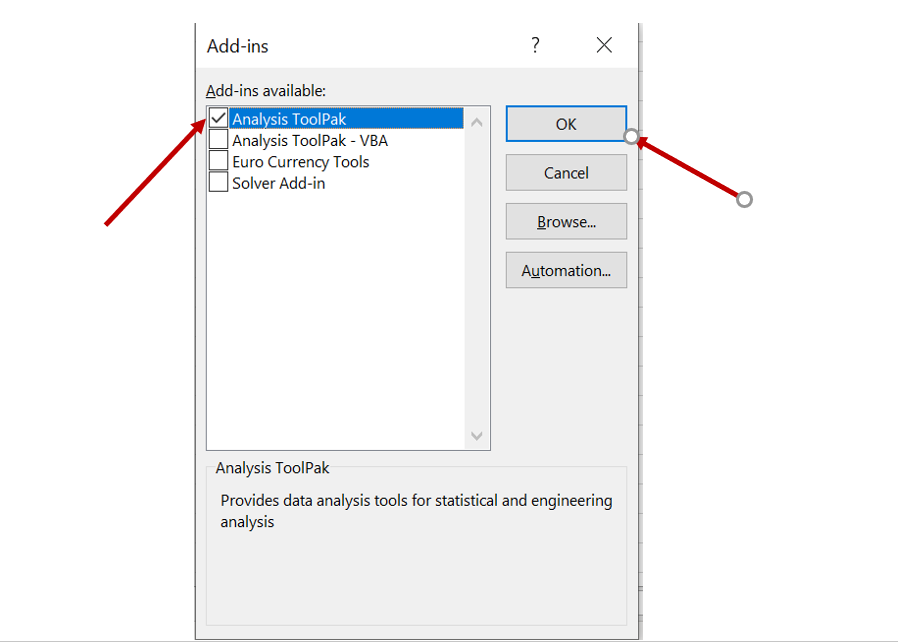

Two sample Z-Test for means with known variances.Įxcel 365 - C:\Program Files\Microsoft Office\Office15\Library\Analysis\PROCDB.XLAM | FUNCRES.XLAM | ANALYS32.DLLĮxcel 2021 - C:\Program Files\Microsoft Office\Office15\Library\Analysis\PROCDB.XLAM | FUNCRES.XLAM | ANALYS32.DLLĮxcel 2019 - C:\Program Files\Microsoft Office\Office15\Library\Analysis\PROCDB.XLAM | FUNCRES.XLAM | ANALYS32.DLLĮxcel 2016 - C:\Program Files\Microsoft Office\Office15\Library\Analysis\PROCDB.XLAM | FUNCRES.XLAM | ANALYS32.DLL T-Test: Two Sample assuming unequal Variances Paired two sample T-Test assuming equal means. T-Test: Two Sample assuming equal Variances Samples a population randomly or periodically.
#INSTALL DATA ANALYSIS TOOLPAK EXCEL 2016 SERIES#
Variance is a measure of how much the values are dispersed around the mean value.ĭiscrete Fourier Transform (DFT) or Fast Fourier Transform (FFT) method, including reverse transforms.Ĭounts occurrences in each of several data bins.Ĭalculates a moving average to allow you to smooth out a data series that contains peaks.Ĭreates a number of several types of random numbers including Uniform, Normal, Bernoulli, Poisson, Patterned and Discrete.Ĭreates a list of the numbers ranked from highest to lowest and also provides a percentile value which indicates how an individual number ranks compared to the other numbers.Ĭreates a table of statistics that result from least-squares regression. Smooths data, weighting more recent data heavier.Ĭompares the variances between two groups of data.

This table includes calculations for: Mean, Standard Error, Median, Mode, Standard Deviation, Sample Variance, Kurtosis, Skewness, Range, Minimum, Maximum, Sum, Count, Largest, Smallest and Confidence Level. This does not include more than one sample of data for each group.Ĭompares two sets of data to determine if there is any relationship between them.Ĭalculates the average of the product of deviations of values from the means of each data set.Ĭalculates a range of statistical measurements and summarises them into a table. This includes more than one sample of data for each group.ĭetermines if there is a relationship between two data sets by performing an analysis of variance. This will give you a choice of the following analysis tools:ĭetermines if there is a relationship between two data sets by performing an analysis of variance.ĭetermines if there is a relationship between two data sets by performing an analysis of variance. Once you have the Analysis-ToolPak add-in installed an extra button will appear at the on the far right of your Data tab. In Excel 2003 this add-in also provided additional worksheet functions, although in Excel 2007 these were included as standard. This add-in should not be installed unless you are going to use the additional Data Analysis functionality as Excel will take slightly longer to open with this add-in installed. This add-in provides a number of additional analysis techniques. This training introduces you to Power BI and delves into the statistical concepts that will help you devise insights from available data to present your findings using executive-level dashboards.The Analysis-ToolPak add-in is a third party Excel add-in that provides special analysis tools suitable for medium scale statistical analysis. This Business Analytics certification course teaches you the basic concepts of data analysis and statistics to help data-driven decision making. Histograms are useful when you want to analyze an enormous set of data quickly.īoost your analytics career with powerful new Microsoft Excel skills by taking the Business Analytics with Excel course, which includes Power BI training You made a histogram chart and adjusted the value and range of the bin. In this article, you have learned about Histograms in MS Excel. Gain expertise in the latest Business analytics tools and techniques with the Business Analyst Master's Program.


In the above case, 20 shows 0 values, which shows that there are 0 employees that are less than age 20. The first bin shows all the values below it. In the Histogram dialogue box, select the Input range, Bin range, and Output range.In the Data Analysis dialog box, select Histogram.Go to the Data tab and click Data Analysis.To create a Histogram, follow the steps mentioned below:


 0 kommentar(er)
0 kommentar(er)
